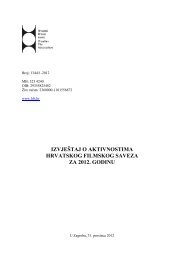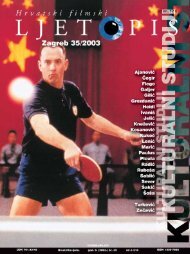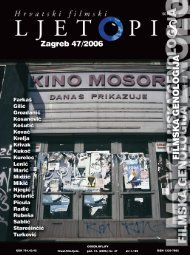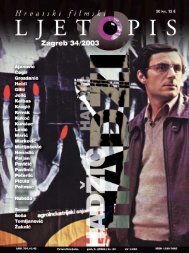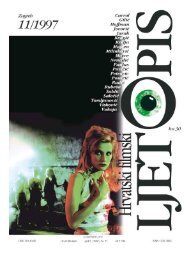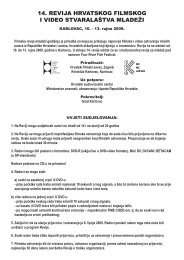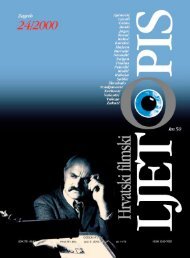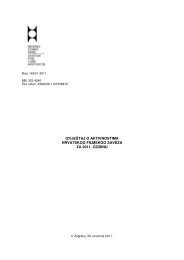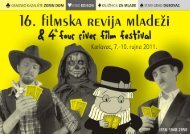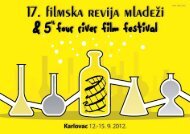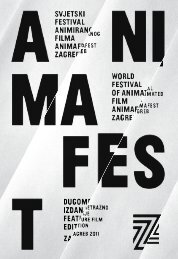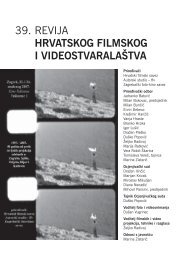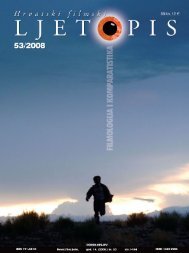Hrvatski filmski ljetopis, broj 26 (2001) - Hrvatski filmski savez
Hrvatski filmski ljetopis, broj 26 (2001) - Hrvatski filmski savez
Hrvatski filmski ljetopis, broj 26 (2001) - Hrvatski filmski savez
You also want an ePaper? Increase the reach of your titles
YUMPU automatically turns print PDFs into web optimized ePapers that Google loves.
ABSTRACTS<br />
Abstracts on Collaborators<br />
UDC: 791.44.071.1(497.5) Dovnikovi} B.<br />
791.43-252(497.5)<br />
Petar Krelja<br />
Stylistic Coherence of Dovnikovi}’s<br />
Opus<br />
Borivoj Dovnikovi}-Bordo had quite an interesting and<br />
unusual artistic development. He left his native town of<br />
Osijek to pursue his dream and become a cartoonist. He<br />
began his career in the weekly satiric magazine Kerempuh<br />
and this work eventually introduced him into the world of<br />
animation through the project The Big Meeting that he<br />
worked on as animator and assistant. Ever since he has<br />
remained in the world of animation, that is to say, for five<br />
decades, with only one interruption when he shortly<br />
returned to his first calling — cartoons. Thus he participated<br />
in all the evolutionary phases of the Zagreb School of<br />
Animated film.<br />
For the first eleven years he mostly collaborated on other<br />
authors’ projects. Only after many years of practice in animation<br />
did he in 1961 come out with his debut film Dolly.<br />
Since then until 1995 a number of other works followed<br />
creating an impressive author’s opus that certainly made<br />
him one the most significant and unavoidable protagonists<br />
of the Zagreb School of Animated film.<br />
The author of the text chose eleven films — Dolly (1961),<br />
Untitled (1964), Curiosity (1966), Krek (1967), Manoeuvres<br />
(1971), Second class passenger (1973), J. D. (1976), The<br />
School of Walking (1978), One Day in Life (1982), Two<br />
Lives (1984), An Exciting Love Story (1989) — which he<br />
analyses in order to reveal the basis of Dovnikovi}’s poetics.<br />
The author establishes that Dovnikovi} was influenced by<br />
Disney, newspaper cartoons and comics, and on these<br />
grounds he created his most important works.<br />
While refusing to accept that characters are one-dimensional<br />
or simple geometric shapes karyokinetically multiplied,<br />
Dovnikovi} accepts the functionality of a simplified, only<br />
slightly coloured surface. He does not hide the fact that his<br />
heroes draw roots from cartoons. Caricature free of sarcasm<br />
or bombastic and spectacular gags is a permanent characteristic<br />
of his work. His works always include a well-known<br />
nice hero of a rather bland appearance, a man from the<br />
fringes of society constantly struggling with repressive<br />
’eager’ individuals or some global destructive forces always<br />
hovering over him.<br />
200<br />
<strong>Hrvatski</strong> <strong>filmski</strong> <strong>ljetopis</strong> <strong>26</strong>/<strong>2001</strong>.<br />
Although the fact that the Zagreb school’s potentials were<br />
never fully realized, that some of its authors quickly gave up<br />
on animation (Mimica, Bourek, Marks, [talter...), while others<br />
died rather young (Grgi}, Kostelac, Vukoti}, Zaninovi},<br />
Vunak) discouraged Borivoj Dovnikovi}, he nevertheless<br />
managed to keep his place on the Croatian and world scene<br />
of animation — as one of the greatest — owing to his personal<br />
vitality and the obvious resilience of his opus that with<br />
time became only more impressive and coherent.<br />
UDC: 791.43:7.025<br />
791.43:681.3<br />
Mato Kukuljica<br />
New Electronic Technologies —<br />
Help in the Restoration of Film<br />
Material<br />
Film art has more than any other art marked the 20th century,<br />
however it is in grave danger of being completely lost<br />
or destroyed. The data about the destruction of film stock<br />
are terrifying. 90% of all the stock from the pioneering period<br />
of cinematography (made before 1910) is lost forever,<br />
along with 50% of the film stock made after the appearance<br />
of sound film (1927) and 50% of all the material made after<br />
the replacement of nitrate based film tape with a secure film<br />
tape with acetate base (in the period from 1950 till 1954).<br />
The efforts of film archivists to restore and preserve the<br />
existing material are only partially successful since they are<br />
encountering many problems, starting with technological<br />
limitations, problems of storage, lack of competent workers<br />
and institutions, specialised laboratories and finally, lack of<br />
financing. We have to add that each film needs to be<br />
restored two, three or four times during the lifetime of an<br />
archivist. In the domain of classical film storage, they are<br />
trying to produce a more stable film tape and to ensure storage<br />
conditions that would prolong the life of film stock for<br />
additional 30-50 years, but even such solutions have their<br />
limitations. Film technologies and researchers estimate that<br />
in the course of next 20-30 years another 50% of presently<br />
preserved film stock will be lost forever due to untimely<br />
protection of nitrate film footage, the spreading of vinegar<br />
syndrome on film material with celluloid base, while a part<br />
of film stock will be lost due to colour fading and deterio-



